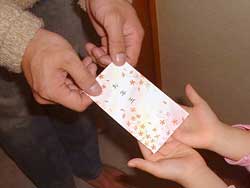|
MONTHLY NEWS O-toshidama: Kids Get New Year Gifts | ||||||||
The Japanese word o-shogatsu, which means "the first month of the year," refers to the New Year period. Since schools are closed for winter break, children in Japan spend the holidays visiting their grandparents or relaxing at home. It is traditional at New Year for grown-ups to give children money. For many kids, the biggest highlight of this time of year is neither the traditional New Year food nor the games they play but these gifts of money, which are called o-toshidama. Traditionally a big rice cake, known as kagami mochi, is offered to a deity in the New Year, and smaller pieces of rice cake are made at the same time for the family to eat. In the old days these small rice cakes were called toshidama and were seen as gifts from the deity. By receiving toshidama, people were thought to become one year older, regardless of their actual birthday. Over time the word came to refer to New Year gifts given by parents to their children and by people in high-ranking positions to their juniors. The gifts were mostly fans, medicines, and rice cakes, but it was not uncommon to give toys to children - kites for boys, for example, and hagoita (wooden rackets) for girls.
Today, cash has mostly replaced these kinds of presents, and o-toshidama (adding the prefix o- is a polite way of saying toshidama) are known as special allowances that are given out during the New Year. Kids can expect to receive o-toshidama from familiar adults, including their parents, grandparents, uncles and aunts, and possibly even their parents' friends and neighbors. The adults put the money in small palm-sized envelopes known as pochibukuro, which are often decorated with cute illustrations. This is because it is considered rude to give cash unwrapped. It is also considered impolite for the recipient to open the envelope on the spot. Checking the inside of the envelope later on is an exciting moment for the children, but sometimes siblings or cousins can get into fights over how much they received. Asaki Shunsuke, a third grader who lives in Miyagi Prefecture, grumbles over the fact that the o-toshidama that he got from his relatives is the same amount as his younger sister's. "My sister is three years younger than me, and she still gets just as much as I do. I feel as if I'm losing out." According to statistics compiled by a Japanese bank in 2003, Japanese children receive o-toshidama from an average of 6.2 adults, and the average total of all the o-toshidama received by one child was about ¥25,000. How do the kids use the money? Most are not given the freedom to use all of the money as they want. Instead, they're allowed to buy relatively cheap things like snacks and comic books with part of the collected money, and the rest they hand to their parents for safekeeping or deposit in a bank. In some households, though, the children are allowed to buy expensive things that they ordinarily wouldn't be able to buy. For Japanese children, the New Year is the most exciting time of year. |
 |

